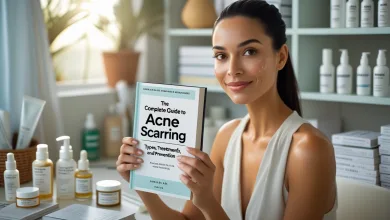Acne Mapping: What Your Breakout Locations Reveal About Your Health

Ever wondered why you keep breaking out in the same spots? It’s not just bad luck—your acne might be sending you important messages about what’s happening inside your body. Let’s decode what your breakout locations reveal about your health through the ancient practice of acne mapping.
What Is Acne Mapping and Why Should You Care?
You’ve probably had those moments—staring into the mirror, wondering, “Why on earth do I keep getting pimples in the exact same spot?” Well, it’s not just a cruel joke from the universe. There’s actually a fascinating explanation behind those recurring breakouts, and it’s called acne mapping.
Acne mapping isn’t just some new-fangled beauty trend; it’s a practice with deep roots in both Traditional Chinese Medicine (TCM) and Ayurveda that dates back thousands of years. These ancient healing systems recognized something modern dermatology is finally catching up to—your skin is essentially a billboard advertising what’s happening inside your body. When your forehead erupts before a big presentation, it’s not merely stress manifesting as a pimple; it could be your body waving a red flag about digestive issues, hormonal imbalances, or even problems with certain organs. Let’s dive into this fascinating connection between your breakouts and your overall health.
The Science Behind Your Skin: How Acne Forms
Before we jump into mapping specific areas, let’s get down to brass tacks about how acne actually forms. It’s not as simple as “dirt clogs pores, pimples happen.” There’s a whole drama unfolding beneath your skin’s surface!
Acne begins when your sebaceous glands go into overdrive, producing excess oil (sebum) that combines with dead skin cells to clog your pores. Enter bacteria—specifically Propionibacterium acnes—which thrives in this environment, triggering inflammation and those dreaded red bumps we know all too well. But here’s where it gets interesting: what triggers these oil glands to misbehave in specific areas of your face can vary wildly. According to a 2018 study published in the Journal of Clinical and Aesthetic Dermatology, factors include hormonal fluctuations, genetic predisposition, dietary choices, stress levels, and even environmental pollutants.
The location of your breakouts isn’t random—it’s your body’s clever way of signaling that something might be out of balance internally. Think of your face as a map where different zones correspond to different internal systems. When one of these systems is struggling, it often manifests as acne in the corresponding facial zone. Pretty wild, right? This connection forms the foundation of what we call “acne mapping” or “face mapping.”
Forehead Acne: Your Digestive System Might Be Screaming for Help
Waking up to a constellation of pimples across your forehead? Your digestive system might be waving a white flag. The forehead is connected to your digestive tract and bladder in traditional face mapping systems, and breakouts here often signal that something’s amiss with your gut health.
Those pesky forehead pimples might be telling you that your diet needs an overhaul. Consuming too much processed food, sugar, or alcohol can wreak havoc on your digestive system, which may manifest as forehead acne. A study published in the Journal of the Academy of Nutrition and Dietetics found significant associations between high-glycemic diets and acne severity. Your body’s way of saying “enough with the junk food already” might just be written across your forehead!
Stress can also be a major culprit here. When you’re stressed, your body produces more cortisol, which can throw your digestive system off balance and trigger breakouts. If you’re burning the candle at both ends, your forehead might be the first place to show it. Try incorporating stress-reduction techniques like meditation, adequate sleep (aim for 7-9 hours), and drinking plenty of water. Some people find that eliminating dairy and refined carbohydrates makes a world of difference for forehead acne. Remember, your skin often clears up about two weeks after making positive dietary changes, so give it time!
Between the Brows: Liver Issues Could Be Lurking
That persistent patch of acne between your eyebrows? It might be time to show your liver some love. In face mapping, this area corresponds to your liver, and breakouts here could indicate that this vital organ is overworked.
Your liver is essentially your body’s detoxification plant, filtering out all the not-so-great stuff you consume. When you overindulge in fatty foods, alcohol, or processed items high in preservatives, your liver has to work overtime. This strain can manifest as acne between your brows. Research from the International Journal of Molecular Sciences suggests that impaired liver function can influence skin conditions, including acne, by affecting hormone metabolism and detoxification pathways.
Looking to give your liver a break? Try cutting back on alcohol and greasy foods for a couple of weeks. Replace them with liver-friendly foods like leafy greens, beets, and plenty of water. Some people find that dandelion tea or lemon water in the morning gives their liver a gentle cleanse. Oh, and don’t underestimate the power of a good night’s sleep—your liver does most of its regenerative work while you’re catching Z’s!
Nose Acne: Heart Health and Blood Pressure Concerns
If your nose constantly sports blackheads or pimples, it might be worth checking in on your cardiovascular health. According to traditional face mapping, the nose is linked to the heart and blood circulation.
Acne on the nose may indicate issues related to blood pressure, cholesterol levels, or poor circulation. A 2015 study in the Journal of Investigative Dermatology found that people with certain types of acne had higher risks of cardiovascular disease later in life, suggesting a possible connection between skin health and heart health.
To address nose acne, consider evaluating your diet for excessive sodium and spicy foods, which can affect blood pressure and circulation. Incorporating heart-healthy options like omega-3 rich fish, whole grains, and antioxidant-packed berries might help clear up your nose while supporting your cardiovascular system. Regular exercise is also crucial—it improves circulation and helps reduce stress, which can be a major acne trigger. Even a brisk 30-minute walk can make a difference!
Cheek Acne: Respiratory System or Lifestyle Habits?
Those stubborn breakouts on your cheeks could be telling you something about your respiratory health or lifestyle habits. In face mapping, the cheeks are associated with the respiratory system, including the lungs.
If you’re noticing persistent cheek acne, it might be time to evaluate your environment. Do you live in a polluted area? Is your workplace filled with irritants? Are you a smoker or exposed to secondhand smoke? All these factors can impact your respiratory system and, consequently, manifest as acne on your cheeks. A 2016 study in the Journal of the European Academy of Dermatology and Venereology found a strong correlation between air pollution exposure and acne severity on the cheeks specifically.
Your phone and pillowcases are also potential culprits. Think about it—your phone is constantly collecting bacteria, which you then press directly against your cheek. Try cleaning your phone daily with a disinfectant wipe and changing your pillowcases at least twice a week. Some people find that switching to hypoallergenic laundry detergent makes a significant difference for cheek acne. And if you suspect respiratory issues might be at play, incorporating activities that support lung health—like deep breathing exercises or even singing—could help clear those cheeks up!
Jawline and Chin: Hormonal Imbalances Are the Usual Suspects
If you’re plagued by painful, cystic acne along your jawline and chin, especially in a cyclical pattern, hormones are likely the culprits. This area is strongly associated with hormonal fluctuations in face mapping traditions.
For many women, chin and jawline breakouts intensify right before or during their menstrual cycle, when hormonal shifts occur. These breakouts are often deeper, more painful, and more stubborn than other types of acne. A comprehensive review in the Journal of Clinical Endocrinology & Metabolism confirms that androgen hormones significantly influence sebum production and acne formation, particularly around the jawline.
Managing hormonal acne requires a multi-faceted approach. While topical treatments can help, addressing the root cause often involves regulating hormones through lifestyle changes or medical interventions. Regular exercise helps balance hormones naturally, while stress management is crucial (cortisol disrupts hormone balance). Some find that eliminating dairy and incorporating spearmint tea (which has anti-androgenic properties) helps. For severe cases, speaking with a healthcare provider about hormone-regulating medications might be necessary. Remember, hormonal acne isn’t just a “female problem”—men can experience it too, especially during significant hormonal changes like puberty or while taking certain supplements.
Back and Chest Acne: When Your Body Joins the Breakout Party
When acne ventures beyond your face to your back and chest, it’s often telling a different story altogether. These areas have larger and more numerous oil glands, making them prime real estate for breakouts.
Back and chest acne (sometimes called “bacne”) can be particularly frustrating because it’s harder to treat due to the skin being thicker in these areas. According to research in the American Journal of Clinical Dermatology, back and chest acne often correlates with excessive sweating, friction from clothing or equipment, and hormone fluctuations.
To tackle body acne, start by evaluating your shower routine. Are you washing off thoroughly after sweating? Try showering immediately after workouts and use a body wash containing salicylic acid or benzoyl peroxide. Wearing loose, breathable fabrics can reduce friction and allow your skin to breathe. Some people find that their laundry detergent is the hidden culprit—fragrance-free, hypoallergenic options might help. If body acne persists despite these measures, a dermatologist can offer stronger treatments like prescription-strength topicals or oral medications.
How to Use Acne Mapping for Personalized Treatment
Now that you understand what your breakouts might be signaling, how do you use this information? It’s all about creating a targeted approach based on where your acne appears most persistently.
The beauty of acne mapping is that it allows you to address not just the symptom (acne) but potentially the cause as well. Instead of applying the same treatment to your entire face, you can target specific areas with appropriate interventions. For example, if your acne mapping suggests digestive issues (forehead breakouts), adding probiotics to your routine might help more than just topical treatments.
Keep a skin journal for a few weeks, noting where breakouts occur and what’s happening in your life—stress levels, diet changes, sleep patterns, menstrual cycle, etc. This can help you identify patterns and triggers specific to your body. Remember that what works for someone else might not work for you, and vice versa. Acne mapping offers clues, not definitive diagnoses, so use it as one tool in your skin health toolkit. If your acne is severe or accompanied by other symptoms, always consult with a dermatologist or healthcare provider who can offer personalized medical advice.
Natural Remedies Based on Your Acne Map
If you’re into natural approaches, there are plenty of remedies tailored to different face mapping zones. Let’s explore some options based on where your breakouts occur:
For forehead acne (digestive issues):
- Probiotics (both topical and internal)
- Digestive enzymes with meals
- Apple cider vinegar toner (diluted)
- Dietary changes: reduce sugar and processed foods
For between-brows acne (liver concerns):
- Milk thistle supplements or tea
- Turmeric masks or supplements
- Dandelion root tea
- Lemon water in the mornings
For nose acne (heart/circulation issues):
- Omega-3 supplements
- Green tea (both drinking and as a topical)
- Hawthorn berry tea
- Regular cardiovascular exercise
For cheek acne (respiratory system/external factors):
- Tea tree oil spot treatment
- Air-purifying plants for your home
- Regular phone and pillowcase cleaning
- Rose water spray throughout the day
For jawline/chin acne (hormonal imbalances):
- Spearmint tea (has anti-androgenic properties)
- Evening primrose oil supplements
- Zinc supplements
- Clay masks focused on lower face
Remember to patch test any new topical remedy and give treatments at least 2-4 weeks before expecting significant results. Natural remedies often work more gradually than pharmaceutical options but may have fewer side effects and additional health benefits beyond skin clearing.
When to See a Professional: Beyond DIY Treatment
While acne mapping and natural remedies can be effective for many people, there are definitely times when professional help is necessary. Your skin might be sending signals that require expert interpretation.
You should consider consulting a dermatologist if your acne is severe, painful, or cystic, as these types can lead to permanent scarring if left untreated. If you’ve tried multiple over-the-counter treatments for at least 12 weeks with no improvement, that’s another sign you might need prescription-strength help. Additionally, if your acne is accompanied by other symptoms like unusual hair growth, weight fluctuations, or irregular periods, it could indicate an underlying medical condition like polycystic ovary syndrome (PCOS) that requires medical attention.
When you do see a professional, bring your acne mapping observations with you. This information can be valuable to your healthcare provider and might help them make more accurate diagnoses or treatment recommendations. Many dermatologists are now recognizing the potential connections between acne locations and internal health, creating more holistic treatment plans that address both the symptoms and potential underlying causes. Don’t be afraid to ask questions and advocate for yourself if you suspect your acne might be related to internal health factors rather than just skin-deep issues.
FAQs About Acne Mapping
Q: How long should I try acne mapping before expecting results? A: Give any new approach at least 4-6 weeks before evaluating its effectiveness. Your skin operates on a roughly 28-day renewal cycle, so you need at least one full cycle to see meaningful changes.
Q: Can acne mapping replace medical advice? A: Absolutely not! Acne mapping is a complementary tool that can provide insights, but it doesn’t replace professional medical diagnosis and treatment. Always consult healthcare providers for persistent or severe skin issues.
Q: Does acne mapping work for all skin types and ages? A: Yes, the principles of acne mapping can apply to all skin types and ages, though the underlying causes might differ. For example, teen acne might be more hormone-driven across all face zones, while adult acne might more closely correlate with the traditional mapping zones.
Q: Can lifestyle changes really clear acne based on mapping? A: Many people do see significant improvements when making targeted lifestyle changes based on their acne mapping patterns. However, results vary depending on individual factors like genetics, severity of underlying issues, and consistency with the new habits.
Q: Is acne mapping scientifically proven? A: Traditional acne mapping is based on ancient healing systems rather than modern clinical trials. However, emerging research is beginning to validate some connections between acne locations and internal health factors. It’s best viewed as a potentially helpful framework rather than definitive medical science.
The Final Word: Listening to Your Skin’s Wisdom
Your skin is your body’s largest organ and a remarkable communicator if you know how to interpret its signals. Acne mapping offers a fascinating lens through which to understand these messages, potentially connecting the dots between your breakouts and internal health.
By paying attention to where your acne appears most persistently, you might uncover patterns that point to specific lifestyle factors, dietary triggers, or health concerns that need addressing. This holistic perspective transforms acne from a purely cosmetic nuisance to a valuable feedback system from your body.
Whether you’re dealing with stubborn forehead breakouts that might signal digestive distress, or hormonal jawline acne that ebbs and flows with your monthly cycle, the key is patience and consistency. True healing—both of your skin and any underlying imbalances—takes time. Combine the wisdom of acne mapping with good dermatological practices, appropriate medical care when needed, and a dose of self-compassion for the journey.
After all, clear skin isn’t just about looking good—it’s often a reflection of feeling good and functioning well from the inside out. Your acne mapping journey might just lead you to health improvements that extend far beyond your complexion.






